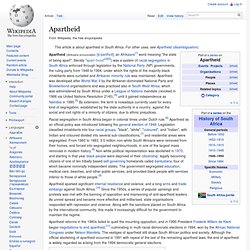

Apartheid in South Africa Laws, History: Documentary Film - Raw Footage (1957) Apartheid impacts are still felt in South Africa. Crime and violence are notoriously high in South Africa.

If you drive around just about anywhere you will see high walls with barbed or concertina wire encircling nearly every middle- or upper-class home. Often, broken glass or metal spikes stick out of the tops of these walls to discourage thieves from climbing over. As I saw these and other safety precautions during my recent trip to South Africa, it caused me to ponder why the crime rate is so high there. I came to the conclusion that the effects of injustice take a long time to heal. Nelson Mandela's Life Story. Effects of Apartheid on the Status of Women in South Africa. Effects of Apartheid on the Status of Women in South Africa 15 July 1980.

Apartheid in South Africa. Racial segregation in South Africa began in colonial times under Dutch rule.[6] Apartheid as an official policy was introduced following the general election of 1948.

Legislation classified inhabitants into four racial groups, "black", "white", "coloured", and "Indian", with Indian and coloured divided into several sub-classifications,[7] and residential areas were segregated. From 1960 to 1983, 3.5 million non-white South Africans were removed from their homes, and forced into segregated neighbourhoods, in one of the largest mass removals in modern history.[8] Non-white political representation was abolished in 1970, and starting in that year black people were deprived of their citizenship, legally becoming citizens of one of ten tribally based self-governing homelands called bantustans, four of which became nominally independent states.
Apartheid didn’t die in South Africa. The murder of 34 miners by the South African police, most of them shot in the back, puts paid to the illusion of post-apartheid democracy and illuminates the new, worldwide apartheid of which South Africa is both a historic and contemporary model.

In 1894, long before the infamous Afrikaans word foretold “separate development” for the majority people of South Africa, an Englishman, Cecil John Rhodes, oversaw the Glen Grey Act in what was then the Cape Colony. This was designed to force blacks from agriculture into an army of cheap labour, principally for the mining of newly discovered gold and other precious minerals. As a result of this social Darwinism, Rhodes’s De Beers companyquickly developed into a world monopoly, making him fabulously rich. In keeping with liberalism in Britain and the United States, he was celebrated as a philanthropist supporting high-minded causes. Today, the Rhodes scholarship at Oxford University is prized among liberal elites.
Transmission line Lesser evil. Reports in English: Teens in South Africa. The first black president of South Africa; (Rechte: dpa) Over the course of the 1980s, the South African government faced increasing domestic and external pressures.

The end to the system of apartheid was unstoppable. However, the reforms of president Pieter Willem Botha, who came to power after the Soweto uprising and remained in office until 1989, were not very far reaching. By the mid 1980s, the charismatic leader of the black population, Nelson Mandela, had already been imprisoned for more than 20 years. All over the world people called for his release. South African town accused of keeping apartheid alive. The South African community of Kleinfontein is accused of keeping apartheid's ideals aliveApartheid was a policy of systematic racial discriminationA Kleinfontein spokeswoman says it is a "cultural community" for Afrikaaners onlyIts residents are accused of using culture and heritage to discriminate against black people (CNN) -- More than two decades after the death of the systematic racial discrimination policy of apartheid, a community living southeast of South Africa's capital Pretoria is being accused of trying to keep its racist ideals alive.

White men clad in military uniforms stamped with an old South African flag guard the gates of the controversial settlement known as Kleinfontein. All the signs within its boundaries are written in Afrikaans, the language that developed out of the Dutch dialect spoken by early colonizers and which is spoken by the town's 1,000 white inhabitants. "I was just sick of crime," she says. Anti-apartheid activist supports women. Apartheid — History.com Articles, Video, Pictures and Facts. In 1976, when thousands of black children in Soweto, a black township outside Johannesburg, demonstrated against the Afrikaans language requirement for black African students, the police opened fire with tear gas and bullets.

The protests and government crackdowns that followed, combined with a national economic recession, drew more international attention to South Africa and shattered all illusions that apartheid had brought peace or prosperity to the nation. The United Nations General Assembly had denounced apartheid in 1973, and in 1976 the UN Security Council voted to impose a mandatory embargo on the sale of arms to South Africa. In 1985, the United Kingdom and United States imposed economic sanctions on the country.
The History of Apartheid in South Africa. South Africa (see map) is a country blessed with an abundance of natural resources including fertile farmlands and unique mineral resources.

South African mines are world leaders in the production of diamonds and gold as well as strategic metals such as platinum.